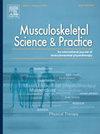(亚)急性非外伤性颈部疼痛患者的运动恐惧症、疼痛灾难化、抑郁和压力筛查问题的构念效度
IF 2.2
3区 医学
Q1 REHABILITATION
引用次数: 0
摘要
颈部疼痛很常见,可由急性转变为慢性,通常受运动恐惧症、疼痛灾难化、抑郁和压力等心理因素的影响。早期筛查这些因素的患者(亚)急性颈痛是至关重要的,以防止慢性。目的探讨荷兰(亚)急性非外伤性颈部疼痛患者运动恐惧症、疼痛灾难化、抑郁和压力筛查问题的结构效度和内部一致性。设计横断面研究。方法对收敛效度和发散效度进行假设。筛选问题与已建立的问卷进行比较:针对运动恐惧症的坦帕量表(TSK-11),针对运动恐惧症的疼痛灾难量表(PCS-6),以及针对抑郁和压力的抑郁、焦虑和压力量表(DASS-21)。当观察到强收敛效度(r≥0.7)时,评估内部一致性。结果运动恐惧症(r = 0.526, TSK-11)、抑郁(r = 0.660, DASS-21抑郁)和应激(r = 0.506)存在中度相关性。DASS-21痛苦)。疼痛灾变与PCS-6有很强的相关性(r = 0.771)。运动恐惧症、疼痛灾难化和压力与不相关构念的相关性≤0.5支持发散效度,但与抑郁无关。疼痛灾难化的内部一致性为0.692。散点图显示运动恐惧症和应激的离散性很广。对于疼痛灾难化,散点图显示低筛选分数与高参考标准分数相关。结论用一两个问题来调查运动恐惧症、疼痛灾难化、抑郁和压力的复杂构念目前尚不可取。需要进一步的研究来证实筛查心理构念的能力。本文章由计算机程序翻译,如有差异,请以英文原文为准。
The construct validity of screening questions for kinesiophobia, pain catastrophizing, depression, and stress in patients with (sub-)acute non-traumatic neck pain
Background
Neck pain is common and may transition from acute to chronic, often influenced by psychological factors like kinesiophobia, pain catastrophizing, depression, and stress. Early screening for these factors in patients with (sub-)acute neck pain is crucial to prevent chronicity.
Objectives
To examine the construct validity and internal consistency of screening questions for kinesiophobia, pain catastrophizing, depression, and stress in Dutch patients with (sub-)acute, non-traumatic neck pain.
Design
Cross sectional study.
Method
Hypotheses were formulated for convergent and divergent validity. Screening questions were compared with established questionnaires: the Tampa Scale for Kinesiophobia (TSK-11) for kinesiophobia, the Pain Catastrophizing Scale (PCS-6) for pain catastrophizing, and the Depression, Anxiety, and Stress Scale (DASS-21) for depression and stress. When strong convergent validity (r ≥ 0.7) was observed, internal consistency was assessed.
Results
Moderate correlations were observed for kinesiophobia (r = 0.526, TSK-11), depression (r = 0.660 DASS-21 depression), and stress (r = 0.506. DASS-21 distress). Pain catastrophizing showed a strong correlation with the PCS-6 (r = 0.771). Divergent validity was supported by correlations ≤0.5 with unrelated constructs for kinesiophobia, pain catastrophizing, and stress, but not for depression. Internal consistency for pain catastrophizing was 0.692. Scatterplots showed wide dispersion for kinesiophobia and stress. For pain catastrophizing, the scatterplot revealed that low screening scores were associated with high reference standard scores.
Conclusions
Investigating the complex constructs of kinesiophobia, pain catastrophizing, depression and stress with one or two questions cannot currently be recommended. Further research is needed to confirm the ability to screen for psychological constructs.
求助全文
通过发布文献求助,成功后即可免费获取论文全文。
去求助
来源期刊

Musculoskeletal Science and Practice
Health Professions-Physical Therapy, Sports Therapy and Rehabilitation
CiteScore
4.10
自引率
8.70%
发文量
152
审稿时长
48 days
期刊介绍:
Musculoskeletal Science & Practice, international journal of musculoskeletal physiotherapy, is a peer-reviewed international journal (previously Manual Therapy), publishing high quality original research, review and Masterclass articles that contribute to improving the clinical understanding of appropriate care processes for musculoskeletal disorders. The journal publishes articles that influence or add to the body of evidence on diagnostic and therapeutic processes, patient centered care, guidelines for musculoskeletal therapeutics and theoretical models that support developments in assessment, diagnosis, clinical reasoning and interventions.
 求助内容:
求助内容: 应助结果提醒方式:
应助结果提醒方式:


